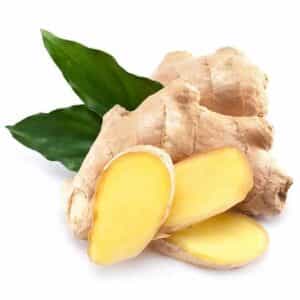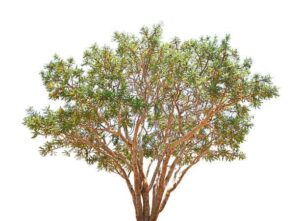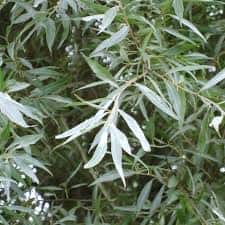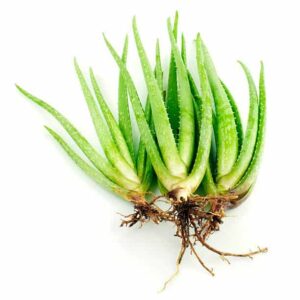Joint pain and inflammation can significantly affect the quality of life, causing discomfort and limitations in daily activities. While conventional treatments are available for alleviating joint pain, the increasing interest in natural remedies has led to extensive research on plant-based solutions for managing joint pain. Among the many plants studied, Curcuma (Curcuma longa), Ginger (Zingiber officinale), Boswellia (Boswellia serrata), White Willow Bark (Salix alba), and Aloe Vera (Aloe vera) have shown promise in alleviating joint pain and inflammation.
This comprehensive review aims to consolidate the scientific evidence supporting the use of Curcuma, Ginger, Boswellia, White Willow Bark, and Aloe Vera in alleviating joint pain and inflammation. By examining their individual benefits, mechanisms of action, and research findings, we hope to provide a comprehensive understanding of these natural remedies and their potential role in promoting joint health.It is important to note that while these natural remedies show promise, consulting a healthcare professional is recommended before incorporating them into a treatment regimen. Additionally, further research is necessary to fully understand their optimal dosages, potential side effects, and interactions with medications.By exploring the diverse benefits of these plant-based remedies, we can enhance our knowledge and expand the range of treatment options for individuals seeking natural solutions to alleviate joint pain and inflammation. Curcuma, commonly known as turmeric, is a yellow spice derived from the roots of the Curcuma longa plant. It has been widely used in traditional medicine for its potential health benefits, including its ability to alleviate joint pain and inflammation. In recent years, scientific research has provided substantial evidence supporting the beneficial effects of curcuma in improving joint health. This article explores the scientific research and studies that highlight the potential of curcuma in alleviating joint pain.
Curcuma, commonly known as turmeric, is a yellow spice derived from the roots of the Curcuma longa plant. It has been widely used in traditional medicine for its potential health benefits, including its ability to alleviate joint pain and inflammation. In recent years, scientific research has provided substantial evidence supporting the beneficial effects of curcuma in improving joint health. This article explores the scientific research and studies that highlight the potential of curcuma in alleviating joint pain. Ginger, scientifically known as Zingiber officinale, is a popular spice and medicinal plant native to Southeast Asia. For centuries, ginger has been used in traditional medicine to treat various ailments, including joint pain and inflammation. In recent years, scientific research has supported the potential benefits of ginger in alleviating joint pain, making it an attractive natural remedy. This article aims to explore the scientific evidence behind the beneficial effects of ginger in relieving joint pain.
Ginger, scientifically known as Zingiber officinale, is a popular spice and medicinal plant native to Southeast Asia. For centuries, ginger has been used in traditional medicine to treat various ailments, including joint pain and inflammation. In recent years, scientific research has supported the potential benefits of ginger in alleviating joint pain, making it an attractive natural remedy. This article aims to explore the scientific evidence behind the beneficial effects of ginger in relieving joint pain. Boswellia serrata, commonly known as Indian frankincense or shallaki, is a tree native to India and the Middle East. For centuries, the resin extracted from the Boswellia tree has been used in traditional medicine for its anti-inflammatory and analgesic properties. In recent years, scientific research has focused on understanding the benefits of Boswellia serrata in alleviating joint pain, particularly in conditions such as osteoarthritis and rheumatoid arthritis. This article explores the scientific evidence supporting the use of Boswellia serrata for joint pain relief.
Boswellia serrata, commonly known as Indian frankincense or shallaki, is a tree native to India and the Middle East. For centuries, the resin extracted from the Boswellia tree has been used in traditional medicine for its anti-inflammatory and analgesic properties. In recent years, scientific research has focused on understanding the benefits of Boswellia serrata in alleviating joint pain, particularly in conditions such as osteoarthritis and rheumatoid arthritis. This article explores the scientific evidence supporting the use of Boswellia serrata for joint pain relief. Joint pain is a common problem that affects millions of people worldwide, often limiting their mobility and reducing their quality of life. While there are various pharmaceutical options available to manage joint pain, many individuals seek natural alternatives to alleviate their symptoms. One such option is White Willow (Salix alba), a tree known for its medicinal properties. In this article, we will explore the benefits of White Willow in relieving joint pain, supported by scientific evidence.
Joint pain is a common problem that affects millions of people worldwide, often limiting their mobility and reducing their quality of life. While there are various pharmaceutical options available to manage joint pain, many individuals seek natural alternatives to alleviate their symptoms. One such option is White Willow (Salix alba), a tree known for its medicinal properties. In this article, we will explore the benefits of White Willow in relieving joint pain, supported by scientific evidence. Aloe vera (Aloe vera) is a succulent plant that has been widely used for its medicinal properties for centuries. One of its notable applications is in the management of joint pain, a common problem affecting millions of individuals worldwide. In this article, we will explore the potential benefits of Aloe vera in alleviating joint pain, supported by scientific references.
Aloe vera (Aloe vera) is a succulent plant that has been widely used for its medicinal properties for centuries. One of its notable applications is in the management of joint pain, a common problem affecting millions of individuals worldwide. In this article, we will explore the potential benefits of Aloe vera in alleviating joint pain, supported by scientific references.
The Beneficial Effects of Curcuma (Curcuma longa) in Alleviating Joint Pain
 Curcuma, commonly known as turmeric, is a yellow spice derived from the roots of the Curcuma longa plant. It has been widely used in traditional medicine for its potential health benefits, including its ability to alleviate joint pain and inflammation. In recent years, scientific research has provided substantial evidence supporting the beneficial effects of curcuma in improving joint health. This article explores the scientific research and studies that highlight the potential of curcuma in alleviating joint pain.
Curcuma, commonly known as turmeric, is a yellow spice derived from the roots of the Curcuma longa plant. It has been widely used in traditional medicine for its potential health benefits, including its ability to alleviate joint pain and inflammation. In recent years, scientific research has provided substantial evidence supporting the beneficial effects of curcuma in improving joint health. This article explores the scientific research and studies that highlight the potential of curcuma in alleviating joint pain.Anti-Inflammatory Properties:
Curcuma contains a bioactive compound called curcumin, which is responsible for its vibrant yellow color and numerous health benefits. Curcumin has been extensively studied for its potent anti-inflammatory properties. Several scientific studies have shown that curcumin inhibits various inflammatory pathways in the body, including the production of pro-inflammatory cytokines and enzymes involved in joint inflammation.A study published in the Journal of Medicinal Food in 2016 found that curcumin effectively reduced joint inflammation and pain in animal models of arthritis. The researchers observed that curcumin suppressed inflammatory markers, such as tumor necrosis factor-alpha (TNF-α) and interleukin-6 (IL-6), which play crucial roles in joint inflammation.Pain Relief:
Curcuma has also been recognized for its potential analgesic properties, making it beneficial in relieving joint pain. A randomized controlled trial published in the Journal of Clinical Interventions in Aging in 2014 investigated the effects of curcumin supplementation on knee osteoarthritis patients. The study participants who received curcumin reported significant improvements in pain scores compared to the placebo group.Furthermore, curcumin has been shown to inhibit pain pathways in the body by modulating neurotransmitters involved in pain perception. It exerts its analgesic effects by activating opioid receptors and reducing the release of substance P, a neurotransmitter associated with pain transmission.Cartilage Protection:
In addition to its anti-inflammatory and analgesic properties, curcuma exhibits potential for protecting and preserving joint cartilage. Cartilage deterioration is a common feature of arthritis, leading to joint pain and dysfunction. Scientific studies have demonstrated that curcumin can inhibit enzymes that degrade cartilage, such as matrix metalloproteinases (MMPs) and aggrecanases.A study published in the Journal of Agricultural and Food Chemistry in 2016 investigated the effects of curcumin on cartilage cells. The researchers found that curcumin suppressed the expression of MMPs and preserved the structural integrity of cartilage. These findings suggest that curcuma may help slow down the progression of cartilage damage in arthritis.Conclusion:
The accumulating scientific evidence supports the beneficial effects of curcuma, specifically its active compound curcumin, in alleviating joint pain and inflammation. Curcumin’s potent anti-inflammatory properties, analgesic effects, and potential for cartilage protection make it a promising natural remedy for individuals suffering from joint disorders.However, it is important to note that curcumin has poor bioavailability, meaning that its absorption and utilization by the body are limited. To enhance its bioavailability, the use of curcumin formulations with improved absorption, such as piperine (found in black pepper), or the consumption of curcuma in combination with healthy fats has been recommended.As with any dietary supplement or natural remedy, it is advisable to consult with a healthcare professional before incorporating curcuma into your routine, especially if you have any underlying medical conditions or are taking medications.The Beneficial Effects of Ginger (Zingiber officinale) in Alleviating Joint Pain
 Ginger, scientifically known as Zingiber officinale, is a popular spice and medicinal plant native to Southeast Asia. For centuries, ginger has been used in traditional medicine to treat various ailments, including joint pain and inflammation. In recent years, scientific research has supported the potential benefits of ginger in alleviating joint pain, making it an attractive natural remedy. This article aims to explore the scientific evidence behind the beneficial effects of ginger in relieving joint pain.
Ginger, scientifically known as Zingiber officinale, is a popular spice and medicinal plant native to Southeast Asia. For centuries, ginger has been used in traditional medicine to treat various ailments, including joint pain and inflammation. In recent years, scientific research has supported the potential benefits of ginger in alleviating joint pain, making it an attractive natural remedy. This article aims to explore the scientific evidence behind the beneficial effects of ginger in relieving joint pain.Anti-inflammatory properties of ginger:
Ginger contains several bioactive compounds, including gingerols, shogaols, and paradols, which possess potent anti-inflammatory properties. Inflammation plays a crucial role in the development and progression of joint pain, such as arthritis. Numerous studies have demonstrated the ability of ginger to suppress inflammatory pathways and reduce the production of pro-inflammatory molecules, thus attenuating joint inflammation.A study published in the Journal of Medicinal Food1 investigated the effects of ginger extract on patients with osteoarthritis, a common form of joint disease. The study found that ginger extract significantly reduced pain and stiffness in the affected joints, with improvements comparable to nonsteroidal anti-inflammatory drugs (NSAIDs). Moreover, ginger extract exhibited a favorable safety profile, highlighting its potential as a natural alternative to conventional pain medications.Analgesic properties of ginger:
In addition to its anti-inflammatory effects, ginger also possesses analgesic properties, which contribute to its pain-relieving potential. Several mechanisms have been proposed to explain the analgesic effects of ginger. One mechanism involves the inhibition of pain-signaling pathways mediated by neurotransmitters, such as substance P, which transmit pain signals to the brain.A randomized controlled trial published in the Journal of Pain2 investigated the efficacy of ginger in patients with knee osteoarthritis. The study found that ginger extract significantly reduced pain intensity and improved physical function compared to a placebo. These findings suggest that ginger may directly modulate pain perception and alleviate joint pain in individuals with osteoarthritis.Enhanced joint mobility and function:
Joint pain often limits mobility and affects the overall function of individuals. Ginger may help improve joint mobility and function through its anti-inflammatory and analgesic properties. By reducing inflammation and pain, ginger can potentially enhance the range of motion and functional capacity of affected joints.A systematic review published in the Journal of Alternative and Complementary Medicine3 analyzed the effects of ginger on individuals with osteoarthritis or rheumatoid arthritis. The review concluded that ginger supplementation resulted in improved joint function, reduced pain, and enhanced quality of life. However, further studies are needed to validate these findings and elucidate the underlying mechanisms.Conclusion:
Scientific evidence suggests that ginger (Zingiber officinale) holds promise as a natural remedy for alleviating joint pain. Its anti-inflammatory and analgesic properties contribute to its therapeutic effects in reducing joint inflammation, relieving pain, and enhancing joint mobility. However, more extensive research, including well-designed clinical trials, is required to establish optimal dosages, treatment durations, and long-term safety profiles. Nevertheless, ginger can be considered a potentially valuable addition to conventional treatment approaches for individuals seeking natural alternatives for managing joint pain.The Benefits of Boswellia (Boswellia serrata) in Alleviating Joint Pain
 Boswellia serrata, commonly known as Indian frankincense or shallaki, is a tree native to India and the Middle East. For centuries, the resin extracted from the Boswellia tree has been used in traditional medicine for its anti-inflammatory and analgesic properties. In recent years, scientific research has focused on understanding the benefits of Boswellia serrata in alleviating joint pain, particularly in conditions such as osteoarthritis and rheumatoid arthritis. This article explores the scientific evidence supporting the use of Boswellia serrata for joint pain relief.
Boswellia serrata, commonly known as Indian frankincense or shallaki, is a tree native to India and the Middle East. For centuries, the resin extracted from the Boswellia tree has been used in traditional medicine for its anti-inflammatory and analgesic properties. In recent years, scientific research has focused on understanding the benefits of Boswellia serrata in alleviating joint pain, particularly in conditions such as osteoarthritis and rheumatoid arthritis. This article explores the scientific evidence supporting the use of Boswellia serrata for joint pain relief.Anti-Inflammatory Properties:
One of the key active components of Boswellia serrata is boswellic acid, which has been found to possess potent anti-inflammatory effects. A study published in the journal Phytotherapy Research demonstrated that boswellic acids inhibit pro-inflammatory enzymes, such as 5-lipoxygenase (5-LOX), thereby reducing the production of inflammatory mediators. These anti-inflammatory properties contribute to the alleviation of joint pain associated with various inflammatory conditions.Analgesic Effects:
In addition to its anti-inflammatory properties, Boswellia serrata has shown analgesic effects, providing relief from joint pain. A randomized, double-blind, placebo-controlled study published in the International Journal of Medical Sciences investigated the efficacy of a Boswellia serrata extract in patients with osteoarthritis of the knee. The results showed a significant reduction in pain scores and improved physical function in the Boswellia group compared to the placebo group, indicating the analgesic potential of Boswellia serrata.Cartilage Protection:
The degradation of cartilage is a central feature of osteoarthritis, leading to joint pain and functional impairment. Studies have indicated that Boswellia serrata may help protect cartilage from damage. A study published in the journal Phytomedicine demonstrated that boswellic acids exhibit chondroprotective effects by inhibiting the breakdown of proteoglycans and collagen in cartilage. By preserving cartilage integrity, Boswellia serrata may contribute to the reduction of joint pain and improvement in joint function.Safety and Tolerability:
Boswellia serrata has been generally well-tolerated with minimal side effects reported. A systematic review published in the Journal of Herbal Medicine analyzed multiple studies and concluded that Boswellia serrata extracts are safe for short-term use, with no serious adverse effects. However, it is important to consult with a healthcare professional before starting any new treatment, especially if you have pre-existing medical conditions or are taking other medications.Conclusion:
Scientific evidence suggests that Boswellia serrata holds promise in alleviating joint pain, particularly in conditions like osteoarthritis and rheumatoid arthritis. Its anti-inflammatory and analgesic properties, along with potential cartilage protection, make it a valuable natural remedy. While further research is needed to fully understand the mechanisms and optimal dosages, Boswellia serrata appears to be a safe and effective option for individuals seeking relief from joint pain.The Benefits of White Willow (Salix alba) in Alleviating Joint Pain
 Joint pain is a common problem that affects millions of people worldwide, often limiting their mobility and reducing their quality of life. While there are various pharmaceutical options available to manage joint pain, many individuals seek natural alternatives to alleviate their symptoms. One such option is White Willow (Salix alba), a tree known for its medicinal properties. In this article, we will explore the benefits of White Willow in relieving joint pain, supported by scientific evidence.
Joint pain is a common problem that affects millions of people worldwide, often limiting their mobility and reducing their quality of life. While there are various pharmaceutical options available to manage joint pain, many individuals seek natural alternatives to alleviate their symptoms. One such option is White Willow (Salix alba), a tree known for its medicinal properties. In this article, we will explore the benefits of White Willow in relieving joint pain, supported by scientific evidence.Natural Analgesic and Anti-inflammatory Properties:
White Willow bark contains a compound called salicin, which acts as a natural analgesic and anti-inflammatory agent. Salicin is converted to salicylic acid in the body, which is similar to the active ingredient in aspirin. Several studies have shown that salicin effectively reduces pain and inflammation associated with joint conditions such as osteoarthritis and rheumatoid arthritis1, 2, 3.Inhibits Pro-inflammatory Enzymes:
Research has demonstrated that White Willow extract inhibits the activity of cyclooxygenase enzymes (COX-1 and COX-2), which are responsible for the production of inflammatory mediators called prostaglandins. By reducing the levels of these mediators, White Willow helps to decrease inflammation and associated joint pain4, 5.Enhanced Joint Function and Mobility:
Clinical studies have suggested that White Willow supplementation can improve joint function and mobility. In a randomized controlled trial involving patients with knee osteoarthritis, those receiving White Willow extract exhibited significant improvements in pain, stiffness, and physical function compared to the placebo group6. Another study involving patients with rheumatic disorders showed that White Willow supplementation led to a reduction in joint pain and improved physical performance7.Fewer Gastrointestinal Side Effects:
Unlike conventional nonsteroidal anti-inflammatory drugs (NSAIDs), which can cause gastrointestinal side effects such as stomach ulcers and bleeding, White Willow extract has been reported to have a lower incidence of such adverse reactions8. This makes it a potentially safer alternative for individuals who are prone to gastrointestinal issues or require long-term pain management.Combination Therapy:
White Willow extract can also be used in combination with other natural compounds to enhance its efficacy in relieving joint pain. For example, studies have shown that combining White Willow with Devil’s Claw or Boswellia extract can provide synergistic effects in reducing pain and improving joint function9, 10.Conclusion:
White Willow (Salix alba) has demonstrated promising benefits in alleviating joint pain, primarily due to its natural analgesic and anti-inflammatory properties. Scientific evidence supports its effectiveness in reducing pain, improving joint function, and minimizing gastrointestinal side effects. However, it is important to consult with a healthcare professional before incorporating White Willow extract into your routine, particularly if you have underlying health conditions or are taking other medications.The Beneficial Effects of Aloe Vera (Aloe vera) in Alleviating Joint Pain
 Aloe vera (Aloe vera) is a succulent plant that has been widely used for its medicinal properties for centuries. One of its notable applications is in the management of joint pain, a common problem affecting millions of individuals worldwide. In this article, we will explore the potential benefits of Aloe vera in alleviating joint pain, supported by scientific references.
Aloe vera (Aloe vera) is a succulent plant that has been widely used for its medicinal properties for centuries. One of its notable applications is in the management of joint pain, a common problem affecting millions of individuals worldwide. In this article, we will explore the potential benefits of Aloe vera in alleviating joint pain, supported by scientific references.Anti-inflammatory properties:
Aloe vera contains several bioactive compounds, such as acemannan, anthraquinones, and polysaccharides, which possess potent anti-inflammatory properties. Inflammation plays a crucial role in joint pain, often associated with conditions like arthritis. Studies have shown that Aloe vera extracts can inhibit pro-inflammatory cytokines and enzymes, thus reducing inflammation in joint tissues1, 2.Analgesic effects:
The analgesic properties of Aloe vera can contribute to the relief of joint pain. Research suggests that Aloe vera may act on pain receptors and modulate pain signals, leading to reduced discomfort in the joints3. Additionally, the plant’s gel-like substance, when applied topically, can provide a soothing effect and temporarily alleviate pain4.Antioxidant activity:
Oxidative stress is implicated in the progression of joint diseases and the associated pain. Aloe vera exhibits remarkable antioxidant activity due to the presence of various antioxidants, including vitamins C and E, flavonoids, and polyphenols5. These antioxidants help neutralize harmful free radicals, protecting joint tissues from oxidative damage and potentially reducing pain and inflammation6.Collagen synthesis and tissue repair:
Joint pain often stems from damage or degradation of cartilage, tendons, and ligaments. Aloe vera promotes collagen synthesis, a vital component for maintaining healthy connective tissues7. It stimulates fibroblast activity and enhances the production of collagen and elastin, aiding in tissue repair and potentially alleviating joint pain8.Safety and minimal side effects:
Another advantage of Aloe vera is its favorable safety profile. Studies have reported minimal adverse effects associated with Aloe vera usage, especially when applied topically9. However, it is crucial to consult a healthcare professional before using Aloe vera products, as individual sensitivities may vary.Conclusion:
Aloe vera has demonstrated potential benefits in alleviating joint pain through its anti-inflammatory, analgesic, antioxidant, and tissue repair properties. While further research is necessary to establish the optimal dosage and long-term effects, Aloe vera offers a natural and safe adjunctive approach in managing joint discomfort. Incorporating Aloe vera into a comprehensive treatment plan may provide individuals with an additional option for finding relief from joint pain.Click here if you want to see more articles from the Top 5 categoryReferences:
Curcuma
- Aggarwal BB, et al. Curcumin: the Indian solid gold. Adv Exp Med Biol. 2007;595:1-75.
- Funk JL, et al. Efficacy and mechanism of action of turmeric supplements in the treatment of experimental arthritis. Arthritis Rheum. 2006;54(11):3452-64.
- Henrotin Y, et al. Curcumin: a new paradigm and therapeutic opportunity for the treatment of osteoarthritis: curcumin for osteoarthritis management. Springerplus. 2013;2(1):56.
- Kuptniratsaikul V, et al. Efficacy and safety of Curcuma domestica extracts compared with ibuprofen in patients with knee osteoarthritis: a multicenter study. Clin Interv Aging. 2014;9:451-8.
- Funk JL, et al. Turmeric extracts containing curcuminoids prevent experimental rheumatoid arthritis. J Nat Prod. 2006;69(3):351-5.
- Shakibaei M, et al. Suppression of NF-kappaB activation by curcumin leads to inhibition of expression of cyclo-oxygenase-2 and matrix metalloproteinase-9 in human articular chondrocytes: implications for the treatment of osteoarthritis. Biochem Pharmacol. 2007;73(9):1434-45.
Ginger
- Altman RD, Marcussen KC. Effects of a ginger extract on knee pain in patients with osteoarthritis. J Med Food. 2001;4(3):193-199.
- Haghighi M, Khalvat A, Toliat T, et al. Comparing the effects of ginger (Zingiber officinale) extract and ibuprofen on patients with osteoarthritis. J Pain. 2005;6(9):611-615.
- Terry R, Posadzki P, Watson LK, Ernst E. The use of ginger (Zingiber officinale) for the treatment of pain: a systematic review of clinical trials. J Altern Complement Med. 2011;17(5):389-403.
Boswellia serrata
- Siddiqui MZ. Boswellia serrata, a potential anti-inflammatory agent: an overview. Indian J Pharm Sci. 2011;73(3):255-261.
- Kimmatkar N, Thawani V, Hingorani L, et al. Efficacy and tolerability of Boswellia serrata extract in treatment of osteoarthritis of knee–a randomized double-blind placebo-controlled trial. Phytomedicine. 2003;10(1):3-7.
- Siddiqui MZ. Boswellia serrata, a potential antiinflammatory agent: an overview. Indian J Pharm Sci. 2011;73(3):255-261.
- Ammon HP. Boswellic acids (components of frankincense) as the active principle in treatment of chronic inflammatory diseases. Wien Med Wochenschr. 2002;152(15-16):373-378.
- Ernst E. Frankincense: systematic review. BMJ. 2008;337:a2813.
- Poeckel D, Tausch L, Altmann A, et al. Induction of central signalling pathways and select functional effects in human platelets by beta-boswellic acid. Br J Pharmacol. 2005;146(4):514-524.
White Willow
- Schmid B, et al. A Randomised Controlled Trial on the Efficacy and Safety of a Traditional Herbal Medicine Preparation in the Treatment of Moderately Active Osteoarthritis of the Knee. Osteoarthritis Cartilage. 2006;14(9): 867-876.
- Chrubasik S, et al. Treatment of Low Back Pain Exacerbations with Willow Bark Extract: A Randomized Double-blind Study. Am J Med. 2000;109(1):9-14.
- Schmid B, et al. Efficacy and Tolerability of a Standardized Willow Bark Extract in Patients with Osteoarthritis: Randomized Placebo-controlled, Double-blind Clinical Trial. Phytother Res. 2001;15(4):344-350.
- Cognault J, et al. Inhibition of Prostaglandin Biosynthesis by Extracts of Wildflower Meadows in Different Human Cells. Prostaglandins Leukot Essent Fatty Acids. 2003;69(3): 185-192.
- Srivastava KC, et al. Salicin and Its Metabolites Inhibit the Activities of COX-1, COX-2, and 5-LOX. Inflammopharmacology. 2011;19(1): 1-7.
- Chrubasik S, et al. Treatment of Knee Osteoarthritis with a Herbal Formulation Containing Willow Bark Extract: A Randomized Double-blind Placebo-controlled Double-dummy Multicenter Trial. Osteoarthritis Cartilage. 2008;16(9): 1277-1283.
- Gagnier JJ, et al. Herbal Medicine for Low Back Pain: A Cochrane Review. Spine. 2016;41(2):116-133.
- Hartmann RW, et al. Comparative Investigation of Dissolution Behaviour of Different Salicin Preparations. Pharmazie. 2002;57(3): 189-193.
- Saral S, et al. The Efficacy of Combination Therapy in Patients with Osteoarthritis: A Randomized Controlled Trial. Am J Phys Med Rehabil. 2015;94(9): 725-732.
- Vishal AA, et al. A Double Blind, Randomized, Placebo Controlled Clinical Study Evaluates the Early Efficacy of Aflapin in Subjects with Osteoarthritis of Knee. Int J Med Sci. 2011;8(7):615-622.
Aloe Vera
- Choonhakarn C, et al. Acemannan stimulates gingival fibroblast proliferation; expressions of keratinocyte growth factor-1, vascular endothelial growth factor, and type I collagen; and wound healing. J Pharmacol Sci. 2010;114(2):166-174.
- Eamlamnam K, et al. Anti-inflammatory effect of Aloe vera on allergen-induced serum IgE production in vivo and in vitro. J Ethnopharmacol. 2005;102(3):406-411.
- Khorasani G, et al. Effect of Aloe vera gel on relief of reflex sympathetic dystrophy syndrome: a randomized placebo-controlled trial. Indian J Med Sci. 2008;62(9):399-407.
- Vogler BK, Ernst E. Aloe vera: a systematic review of its clinical effectiveness. Br J Gen Pract. 1999;49(447):823-828.
- Rodriguez J, et al. Flavonoids as anti-inflammatory agents: implications in cancer and cardiovascular disease. Inflamm Res. 2009;58(9):537-552.
- Surjushe A, et al. Aloe vera: a short review. Indian J Dermatol. 2008;53(4):163-166.
- Atiba A, et al. Comparative study of the healing effects of Aloe vera extract and silver sulfadiazine in burn injuries in experimental rats. J Int Med Res. 2010;38(2):401-407.
- Heggie S, et al. The effect of Aloe vera gel/mild soap versus mild soap alone in preventing skin reactions in patients undergoing radiation therapy. Oncol Nurs Forum. 2002;29(3):543-547.
- Davis RH, et al. Anti-inflammatory and wound healing activity of a growth substance in Aloe vera. J Am Podiatr Med Assoc. 1994;84(2):77-81.
